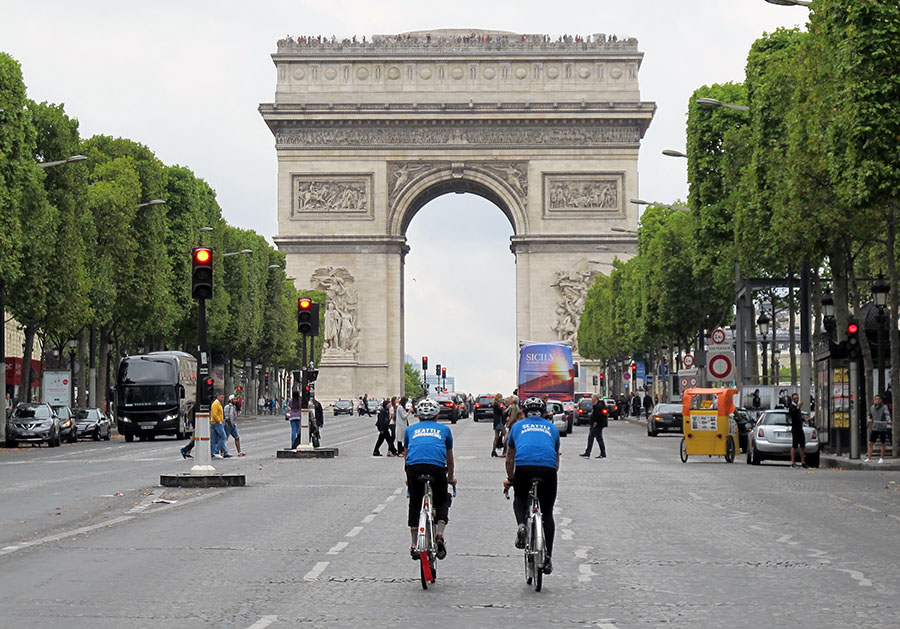Retracing the first Paris-Brest-Paris

The first Paris-Brest-Paris was held as a “utilitarian race” in 1891. Organized by the newspaper Le Petit Journal, the big event started with a parade through Paris, before the cyclists raced off toward France’s westernmost city, some 600 km distant.
On our way to the pre-ride bike check of this year’s PBP, Hahn, Theo and I decided to retrace the beginning of the very first Paris-Brest-Paris.

We met in front of Notre Dame. The original PBP did not go here, but Notre Dame is considered the “center of France”, and the first Flèches Vélocio started here. Left to right: Steve T. (who couldn’t join us), Hahn, Jan, Theo.

The original PBP started at the building of Le Petit Journal in the Rue Lafayette. The offices of Le Petit Journal occupied the center of the block (above), but they’ve been replaced by a modern building that attempts in vain to echo the grand portal of the original (below).

However, the adjacent buildings remain, giving a feel for the architecture. And best of all, cyclists still parade down Rue Lafayette. Today, they ride the wildly popular Vélib ride-share bikes.

Led by organizer Pierre Giffard and by the president of the Union Vélocipédique de France, more than 200 racers paraded through town, followed by hundreds of spectators on bicycles.
We followed their original route via the Place de l’Opéra and the Place de la Concorde (above). In 1891, thousands of spectators were lining the streets, and on each square, marching bands and orchestras played. In 2015, we were almost alone on the streets of Paris on this Saturday morning.
From here, we went up the Champs Elysées toward the Arc de Triomphe (photo at the top of the post). The actual race then started in the Bois de Boulogne, a large park that borders the Seine. We don’t know exactly where the start was.

The racers climbed the hill of Suresnes and went through Saint-Cloud (above). Back then, the Eiffel Tower was brand-new and highly controversial. Today, it’s one of the icons of Paris.

The first real hill of the race was the Côte de Picardie. The eventual winner, Charles Terront, was the first to arrive at the top, led by his pacemakers (which were then allowed in the race). Spectators lined the road, and wondered: “How long until he will come the other way?” Estimates ranged from 70 hours to 5 days…

The racers then “flew” through Versailles and passed the famous chateau. We took our time to stop and look at the impressive façades.
From here, we followed the original course for a few more kilometers, before turning off to head to today’s start in Guyancourt. On the way back, we retraced our steps and passed a commemorative plaque that answers the early-day spectators’ question.

At the exit of Versailles, Terront was in the lead again after a most exciting and eventful race. 71:16 hours after he started, he stopped for a last time before heading to Paris as the winner of the great race. After Terront’s death in 1933, this stone plaque was mounted on the restaurant where he had rested for a few minutes. When the building was demolished, the plaque was saved and mounted on a stone.
On our way back, we decided to follow the course of the post-war Paris-Brest-Paris instead of retracing our steps: We headed across the Seine to arrive at the restaurant Aux Trois Obus at the Porte de Saint-Cloud.

Theo recreated the famous photos taken at the finish by the great photographer Maurice Berton. Below is Roger Baumann, the fastest single-bike riders in 1956.

It is remarkable how little Paris has changed over the 124-year history of Paris-Brest-Paris. To me, that is one of the main appeals of riding this event: You really feel like you are riding in the wheel tracks of great riders like Charles Terront and Roger Baumann.
For further reading about the fascinating history of Paris-Brest-Paris, we recommend:
- Bicycle Quarterly No. 50: The story of the 1891 Paris-Brest-Paris, translated from Bernard Déon’s classic book Paris-Brest Et Retour.
- Jacques Seray’s Paris-Brest-Paris, with hundreds of incredible photos from his collection. (French text, but the photos alone are worth the cover price.)
- René Herse, with photos and stories of PBP during the post-war years, when most of the fastest riders were part of René Herse’s team.


